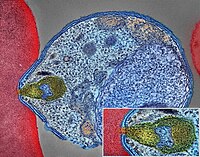
Cytotoxic T Lymphocyte Granzyme-b mediates neuronal cell death during Plasmodium berghei ANKA induced experimental cerebral malaria
Sign Up to like & getrecommendations! Published in 2018 at "Neuroscience Letters"
DOI: 10.1016/j.neulet.2017.11.021
Abstract: Cerebral malaria is a complex, acute, neurological disease characterised by a sudden onset of cerebral symptoms. This disease is manifested as initial arousable stage that is followed by an unarousable coma and eventually death. Parasite… read more here.
Keywords: death; cytotoxic lymphocyte; granzyme; experimental cerebral ... See more keywords

Reversal of cerebrovascular constriction in experimental cerebral malaria by L-arginine
Sign Up to like & getrecommendations! Published in 2018 at "Scientific Reports"
DOI: 10.1038/s41598-018-34249-2
Abstract: Vascular dysfunction associated with low nitric oxide (NO) biavailability and low plasma L-arginine levels is observed in both human and experimental cerebral malaria (ECM). In ECM, cerebrovascular constriction results in decreased pial blood flow and… read more here.
Keywords: administration; cerebrovascular constriction; arginine; constriction ... See more keywords

L-arginine supplementation and thromboxane synthase inhibition increases cerebral blood flow in experimental cerebral malaria
Sign Up to like & getrecommendations! Published in 2019 at "Scientific Reports"
DOI: 10.1038/s41598-019-49855-x
Abstract: Cerebral malaria pathogenesis involves vascular dysfunction with low nitric oxide (NO) bioavailability, vasoconstriction and impaired vasodilation, leading to ischemia, tissue hypoxia and ultimately death. Cerebral blood flow (CBF) involves NO and other pathways, including arachidonic… read more here.
Keywords: blood flow; arginine supplementation; blood; experimental cerebral ... See more keywords

Efficient Treatment of Experimental Cerebral Malaria by an Artemisone-SMEDDS System: Impact of Application Route and Dosing Frequency
Sign Up to like & getrecommendations! Published in 2021 at "Antimicrobial Agents and Chemotherapy"
DOI: 10.1128/aac.02106-20
Abstract: Artemisone (ART) has been successfully tested in vitro and in animal models against several diseases. However, its poor aqueous solubility and limited chemical stability are serious challenges. ABSTRACT Artemisone (ART) has been successfully tested in… read more here.
Keywords: art; treatment; route; experimental cerebral ... See more keywords

The Glycosylphosphatidylinositol Transamidase Complex Subunit PbGPI16 of Plasmodium berghei Is Important for Inducing Experimental Cerebral Malaria
Sign Up to like & getrecommendations! Published in 2018 at "Infection and Immunity"
DOI: 10.1128/iai.00929-17
Abstract: In animal models of experimental cerebral malaria (ECM), the glycosylphosphatidylinositols (GPIs) and GPI anchors are the major factors that induce nuclear factor kappa B (NF-κB) activation and proinflammatory responses, which contribute to malaria pathogenesis. GPIs… read more here.
Keywords: pbgpi16; transamidase; gpi; experimental cerebral ... See more keywords

Rational-Based Discovery of Novel β-Carboline Derivatives as Potential Antimalarials: From In Silico Identification of Novel Targets to Inhibition of Experimental Cerebral Malaria
Sign Up to like & getrecommendations! Published in 2022 at "Pathogens"
DOI: 10.3390/pathogens11121529
Abstract: Malaria is an infectious disease widespread in underdeveloped tropical regions. The most severe form of infection is caused by Plasmodium falciparum, which can lead to development of cerebral malaria (CM) and is responsible for deaths… read more here.
Keywords: discovery novel; based discovery; cerebral malaria; novel carboline ... See more keywords

Hydrogen sulfide protects against the development of experimental cerebral malaria in a C57BL/6 mouse model
Sign Up to like & getrecommendations! Published in 2017 at "Molecular Medicine Reports"
DOI: 10.3892/mmr.2017.6854
Abstract: Hydrogen sulfide (H2S) has anti-inflammatory and neuroprotective properties, particularly during pathological processes. Experimental cerebral malaria (ECM), which is caused by vascular leakage into the brain, is characterized by inflammation, neurological deficits and cerebral hemorrhage. The… read more here.
Keywords: experimental cerebral; cerebral malaria; ecm; hydrogen sulfide ... See more keywords